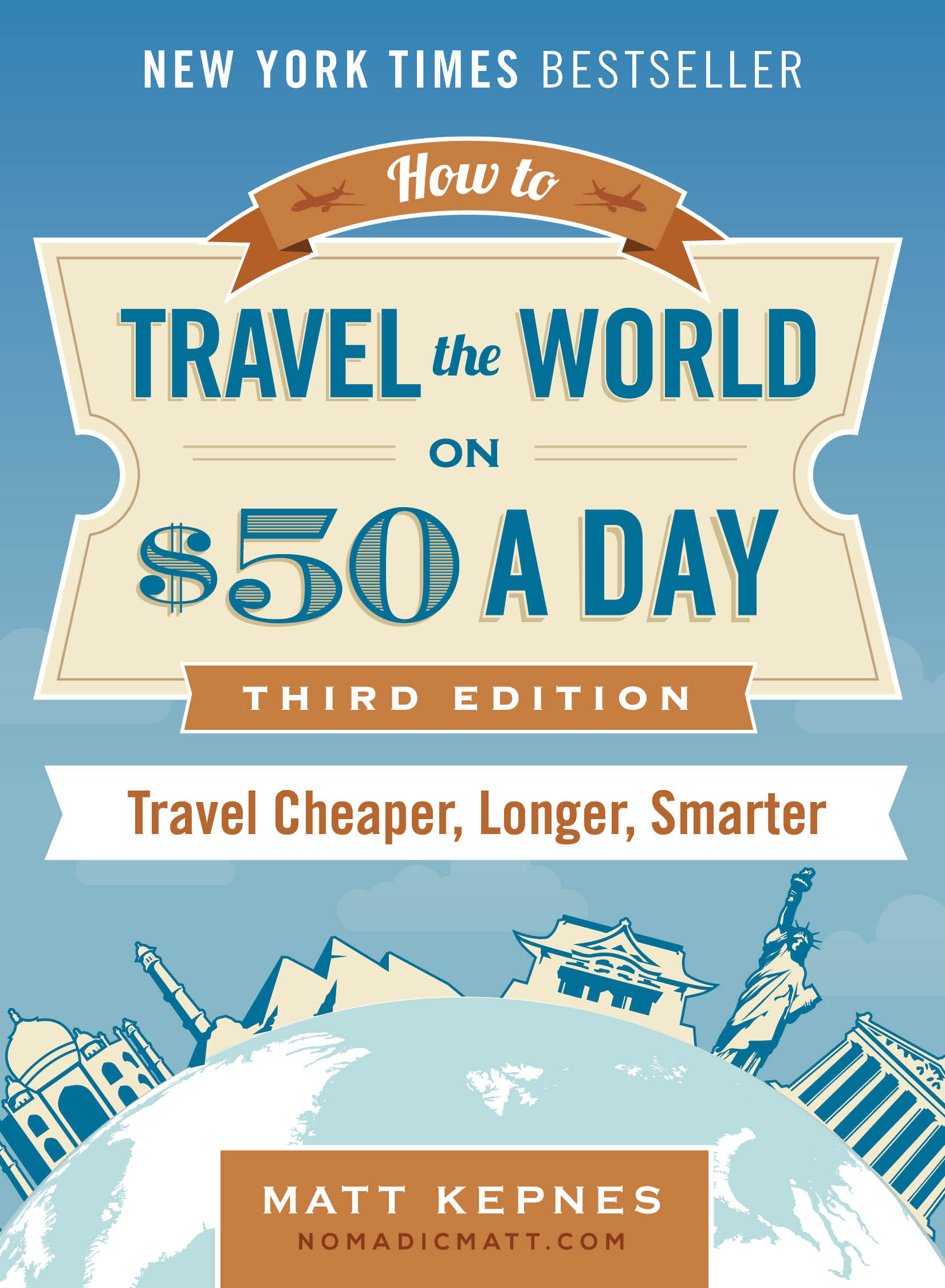
Posted: 2/18/2019 | February 18th, 2019
Lisbon is known to have some of the best hostels in the world.
There are more than 100 hostels in the city and its hostels are usually always at the top of all the “best hostels” lists. Year over year, they always take home some of the top spots in the top-rated lists you see floating around the web.
As someone who’s been to Lisbon multiple times, I can always see why.
Hostels in this city just get it.
They create a warm, social atmosphere, hire friendly and outgoing staff, keep the places clean, offer tons of free food and booze (the key to any backpacker’s heart), and have super comfy beds. You can almost always find free walking tours and other activities, and/or free dinners, snacks, and drinks. This can save you tons of money.
I love every hostel I’ve stayed in here.
Each time I return, I find more and more great places to stay.
And hostels are cheap here too!
You can find dorms with 8-10 beds at about €14 ($16 USD) per night and dorms with 4-6 beds average about €18 ($21 USD) per night. You can find private dorms that sleep 2 in a double bed starting at €40 ($46 USD), with most averaging about €50 ($57 USD) per night.
So what are the best hostels in Lisbon?
Here is my list of favorites for your next visit.
12 Best Hostels in Lisbon
1. Lookout! Lisbon Hostel

This fun and social hostel has a ton of organized activities going on each week – and they even give you free sangria! There’s also a free breakfast buffet. The kitchen and lounge areas always have people around, but it’s not so much a party place – the staff makes sure the hostel is quiet after 11:30pm. There is a free flea market walking tour, as well as a whole host of other paid excursions like surf lessons, beach days, and bicycle rides. You’re a 5-minute walk from Bairro Alto bars, vintage markets, supermarkets, and all-you-can-eat sushi (plus tons of other restaurants).
Beds from €11 EUR ($13 USD). Cash only.
—-> Click here to book your stay at Lookout! Lisbon Hostel!
2. Lisboa Central Hostel
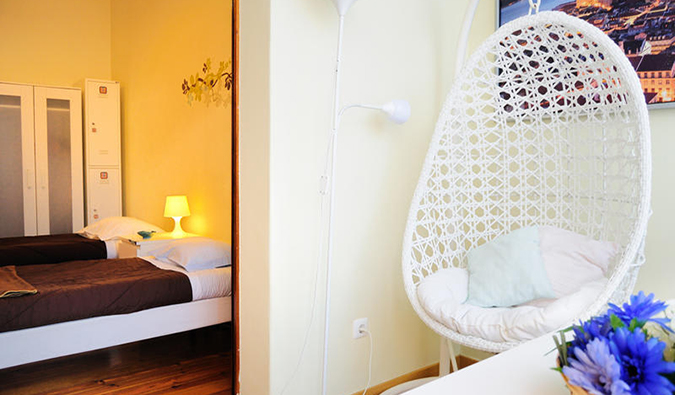
Bright, spacious rooms welcome you here where the beds are comfy and equipped with outlets for you too. Run by a local Portuguese family, the staff here is extremely knowledgeable about the city and can give you great recommendations on things to do and where to eat. There’s free pancake breakfasts and free soup each dat as well as Milkshake Mondays, Tapas Tuesdays, and Sangria Fridays. You won’t have to sepdn a lot of money on food thanks to this hostel. It’s a great vibe here.
Beds from €13 EUR ($15 USD). Twin privates from €52 EUR ($60 USD).
—-> Click here to book your stay at Lisboa Central Hostel!
3. Yes! Lisbon Hostel
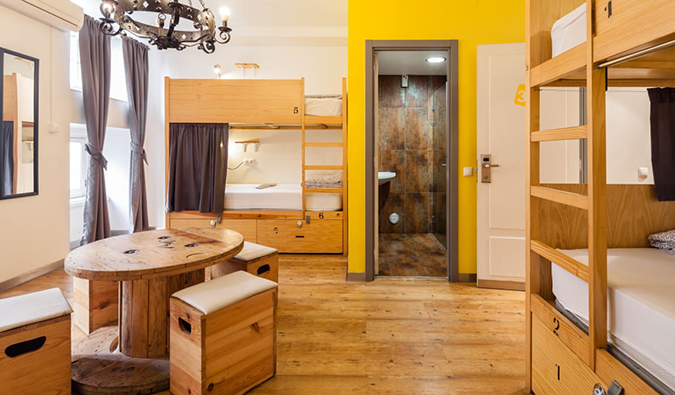
This is a bit of a party hostel but, despite its party atmosphere, the hostel’s facilities are super modern, kept clean, and the spacious rooms are pretty quiet too. They come with privacy curtains, ensuite bathrooms, and the bigger rooms even have a tabel! The €10 EUR ($11 USD) communal dinners are tasty, and they even offer vegetarian options (but if you’d rather do your own cooking, there’s a large kitchen to do so).
Beds from €14 EUR ($16 USD). Private rooms from €68 EUR ($78 USD).
—-> Click here to book your stay at Yes! Lisbon Hostel!
4. Home Lisbon Hostel
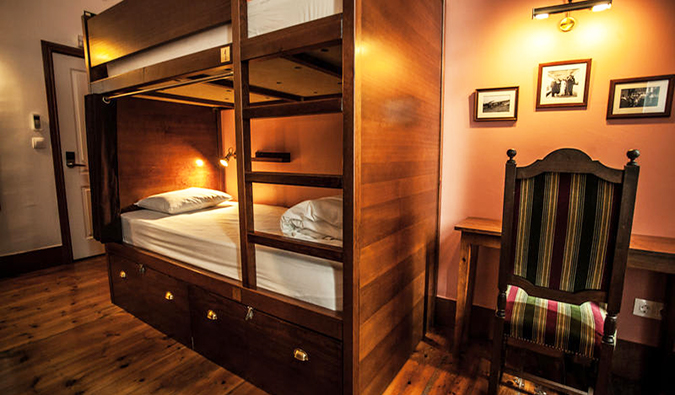
This place in Lisbon’s historic city center is like your home away from home. You’ll even get to meet “Mamma” (the owner’s mom), as she prepares a meal each night. There is also a night tour every evening. The rooms are spacious with balconies and big windows and the bunks have privacy curtains. If you’re a digital nomad, you can take advantage of the co-working space too.
Beds from €15 EUR ($17 USD). Private rooms from €60 EUR ($70 USD).
—-> Click here to book your stay at Home Lisbon Hostel!
5. Nomad 64

Nomad 64 is more like a boutique hostel, and the building has recently been renovated with modern décor. The kitchen is amazing (seriously, there are marble countertops): it’s huge, modern, with lots of tables, and great facitilites. It’s one of the best kitchens I’ve ever seen. Breakfast is included here. The beds are comfy enough. Try to avoid a room with the triple bunks though! Nomad 64 is set in the Santo Antonio district, with a handful of good restaurants nearby. You’re just a 20-minute walk from Bairro Alto.
Beds from €20 EUR ($23 USD). Private rooms from €57 EUR ($65 USD).
—-> Click here to book your stay at Nomad 64!
6. Travellers House

There are two main things I love about this centrally located hostel in the Baixa neighborhood. First is the free breakfast. It is not a “continental” breakfast – there are eggs, bacon, toast, and more. You can even get some items made to order! The second thing I love about this place is the rooftop overlooking the Rua Augusta Arch. The mattresses are thick and comfortable, and you’ll get a light and outlet. The common area feels more like a living room, with beanbag chairs and large couches. Travellers House also hosts a wide range of events such as wining tastings and walking tours through the Alfama and Bairro Alto areas.
Beds from €20 EUR ($23 USD). Private singles from €30 EUR ($34 USD). There is a minimum two-night stay.
—-> Click here to book your stay at Travellers House!
7. We Love F. Tourists
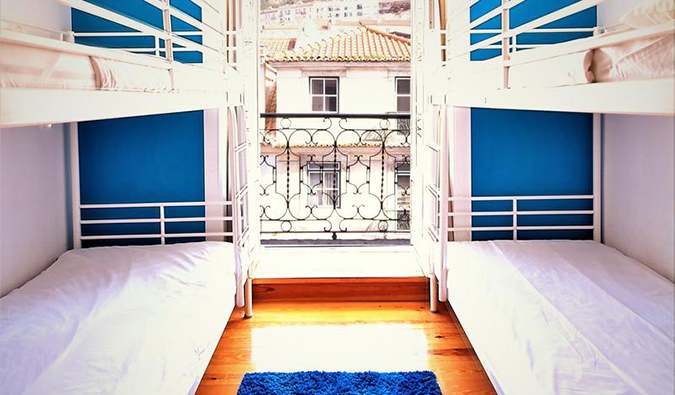
The staff members at We Love F. Tourists are awesome, and it’s not uncommon for them to surprise you with free wine (sometimes they’ll even pack snacks or sandwiches for you as you’re heading to the airport). Sit in the lounge, sip some port, or take in the views over Sao Jorge Castle – it doesn’t get much better than that! This hostel is in Baixa, next to the busy squares of Praça da Figueira and Rossio. Pedro, the owner, has a restaurant next door that serves great food.
Beds from €14 EUR ($16 USD). Private rooms from €50 EUR ($57 USD).
—-> Click here to book your stay at We Love F. Tourists!
8. Lost Inn Lisbon
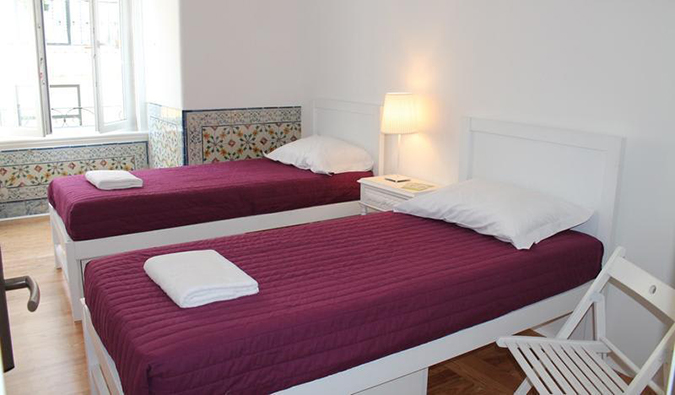
Lost Inn is another hostel that has free sangria (and coffee and tea!) every day. Breakfast is also free, and there’s a free walking tour afterwards. This hostel is housed inside an 18th-century palace in the middle of downtown, next to important monuments, museums, and the party area of Bairro Alto. Despite its age, the building’s interior is sleek and modern (and large – you’ll have no problem getting a bed).
Beds from €15 EUR ($17 USD). Private rooms from €70 EUR ($80 USD). There is a minimum two-night stay.
—-> Click here to book your stay at Lost Inn Lisbon!
9. Living Lounge Hostel

This boutique hostel on the border between the Chiado district and the historic Baixa is interesting and artsy. Each room has a different theme, and local artists have hand-painted the walls. It’s a quirky place in a great location! The beds are nice, but they can be squeaky. They have free pancakes for breakfast, and huge group dinners (for about €10 EUR/$11 USD). They also offer tours; the Fado tour is a popular one.
Beds from €16 EUR ($18 USD). Single privates from €30 EUR ($34 USD).
—-> Click here to book your stay at Living Lounge Hostel!
10. Happy Mike Hostel

There really is a Mike who runs this hostel, and he really is a happy guy! He knows all about the city and is really willing to help you make the most of your time here. Ask him anything. The hostel is sparkling clean, and the well-equipped kitchen has plenty of storage for your groceries. Happy Mike Hostel is located in Benfica – one of the less touristy areas of the city – surrounded by really great dining options and plenty of public transit options.
Beds from €18 ($21 USD). Private rooms from €50 EUR ($57 USD).
—-> Click here to book your stay at Happy Mike Hostel!
11. Good Morning Lisbon Hostel
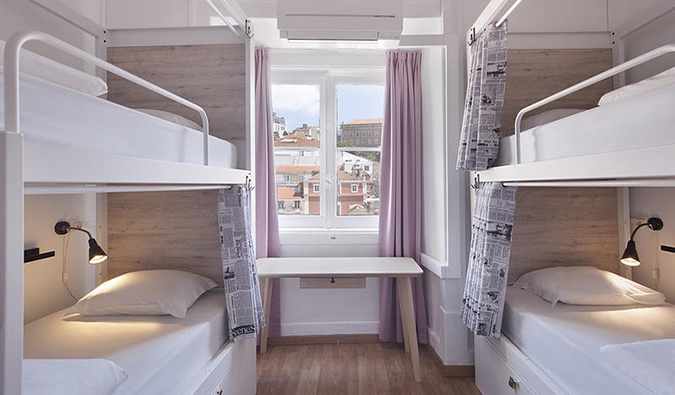
This hostel is right across from busy Restauradores Square and offers everything you need – comfy beds, spacious and clean rooms, free breakfast, a nice staff, and organized activities and walking tours. You can take a free walking tour or bike To Belém to see some of Lisbon’s most historical sites. There’s also a “Power Hour” (i.e., Happy Hour) with free beer and sangria each night. Oh, did I mention the waffles with Nutella? I really love the free cooking class and the day trip with João – he’s fantastic. Breakfast is included here.
Beds from €14 EUR ($16 USD). Private rooms from €56 EUR ($64 USD).
—-> Click here to book your stay at Good Morning Lisbon Hostel!
12. Goodnight Hostel

Not related to the above Good Morning Hostels (they used to be though, this downtown hostel offers free sangria and €10 EUR ($11 USD) dinners once a week. They also organize nights out, as well as a number of walking tours through Alfama, Bairro Alto, and Baixa-Chiado. It’s a great way to get oriented with Lisbon! The showers have amazing water pressure, and the beds are very cozy. The small setting is very intimate due to its small space, making it easy to meet fellow travelers! Free breakfast is included. It’s one of the best hostels in Lisbon. (Actually, it’s my favorite. I saved the best for last!)
Beds from €10 EUR ($11 USD), privates from €55 EUR ($63 USD).
—-> Click here to book your stay at Goodnight Hostel!
Lisbon has so many great hostels spread throughout the city. I’ve been visiting Lisbon for years and have stayed at some amazing places. Instead of spending hours trying to figure out where to stay, this list of the best hostels in Lisbon will cut out the time for you.
Got a hostel not on this list? Add it in the comments!
Book Your Trip to Lisbon: Logistical Tips and Tricks
Book Your Flight
Find a cheap flight by using Skyscanner or Momondo. They are my two favorite search engines because they search websites and airlines around the globe so you always know no stone is left unturned.
Book Your Accommodation
You can book your hostel with Hostelworld. If you want to stay somewhere other than a hostel, use Booking.com as they consistently return the cheapest rates for guesthouses and cheap hotels. I use them all the time.
Don’t Forget Travel Insurance
Travel insurance will protect you against illness, injury, theft, and cancellations. It’s comprehensive protection in case anything goes wrong. I never go on a trip without it as I’ve had to use it many times in the past. I’ve been using World Nomads for ten years. My favorite companies that offer the best service and value are:
- World Nomads (for everyone below 70)
- Insure My Trip (for those over 70)
Looking for the best companies to save money with?
Check out my resource page for the best companies to use when you travel! I list all the ones I use to save money when I travel – and I think will help you too!
Looking for more information on visiting Lisbon?
Check out my in-depth destination guide to Lisbon with more tips on what to see, do, costs, ways to save, and much, much more!
Photo credits: 2, 3, 4, 5, 6, 7, 8, 9, 10, 11, 12, 13
The post My Top 12 Hostels in Lisbon in 2019 appeared first on Nomadic Matt's Travel Site.







